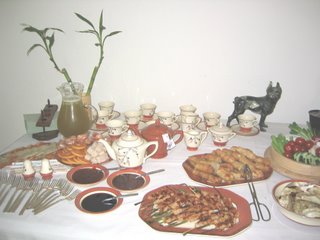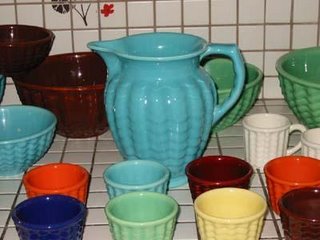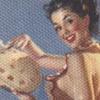Thursday, January 25, 2007

The Gladding McBean Corporation is the unknown and unsung hero of American dinnerware.
Under the label of "Franciscan Ware", they manufactured in not only the most popular dinnerware pattern ever sold in America- Desert Rose- but participated in the wave of California pottery art ware and table ware that still stands today as some of the most sought after in the world.
Having participated with many friends in an on line community of collectors and lover of GMcB for 7 years, it is my privilege to share some of the most lovely art you will ever encounter, post photos of the exquisite pieces still available to collectors today, and highlight some of the wonderful people that make the search worth while.
 The man most responsible for many of us learning about Fran and finding our passion is James Elliot-Bishop (here with Patrick on his right).
The man most responsible for many of us learning about Fran and finding our passion is James Elliot-Bishop (here with Patrick on his right).James wrote the definitive works available on Gladding McBean Pottery, "Franciscan, Catalina, and Other Gladding McBean Wares" (known amongst the faithful as "the red book or James I"), and it's follow up guide "Franciscan Hand Decorated Embossed Dinnerware" ("the yellow book or James II"). Both are available through Schiffer Publishing.


James's research and love of pottery led him to meet many of the serious collectors around the country and create a Yahoo group to help find out more while he worked on his books. Eventually, those of us that joined up found each other, formed social groups, friendships and long serious ties.
We make large group meetings once or twice a year, and have many smaller group gatherings amongst our friends. Most of us have at least 2 or 3 other collectors that we have visited, gone on trips with, and shared far more than just a love of glazed pottery.
Wednesday, January 24, 2007
 Hawthorne, a seeminly simple pattern when you see just one plate, takes on amazingly dramatic and elegant tones when given space and having all it's serving peices to show off the beauty of the pattern.
Hawthorne, a seeminly simple pattern when you see just one plate, takes on amazingly dramatic and elegant tones when given space and having all it's serving peices to show off the beauty of the pattern.Tuesday, January 23, 2007
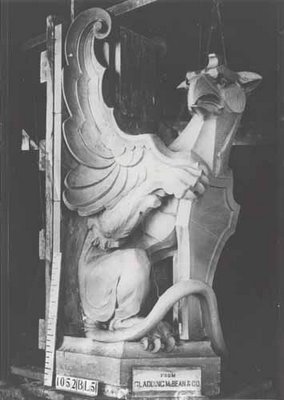 GMcB, famous for it's architectural works, created most of the fabulous decorative building design in California and through the USA.
GMcB, famous for it's architectural works, created most of the fabulous decorative building design in California and through the USA.Recent finds thought lost due to poor record keeping and several quick sales of the original archives have come to light, and a donation to the California State Library Foundaton was recently announced.
For the first time in many decades, we can once again view some of the most magnificent terra cotta works ever created, many massive in size and empowering in their vision.
More information can be found at:
http://www.cslfdn.org/newarrivals.html
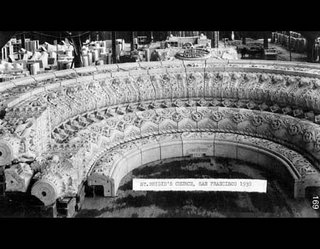
St. Brigid's Church in San Francisco is another location where GMcB is well known. They currently have a site to help repair the church, complete with detailed photos supplied by the company showing the magnificent work they did. http://www.st-brigid.org/building.htm
Sunday, January 21, 2007
Collectors spend hours trying to finish sets, collect hard to find pieces, and "match" their items.
Unless you are seriously avoiding serving food and focused on artware, the hunt in gathering the plates- in their many varieties- is part of the fun.
 GMcB created literally hundreds of patterns over the years, on perhaps a hundred various style forms. Their standard setting, however, remained fairly consistant over time, even if the names of the plates did not.
GMcB created literally hundreds of patterns over the years, on perhaps a hundred various style forms. Their standard setting, however, remained fairly consistant over time, even if the names of the plates did not. Photo 1: Padua Bread and Butter 6.5" & Padua Luncheon 10.5"
 Starting with their first dinnerware line, "El Patio", (known to collectors as "the never ending hobby" for it's diverse shapes, colors, and service ware), a general tone and basic 'place setting' was created that lasted through the years. The GMcB corporation, creating dinnerware as GMcB, Tropico, Catalina, and eventually their signature "Franciscan" lines, offered the same sized plates in most patterns over more than 60 years of operations.
Starting with their first dinnerware line, "El Patio", (known to collectors as "the never ending hobby" for it's diverse shapes, colors, and service ware), a general tone and basic 'place setting' was created that lasted through the years. The GMcB corporation, creating dinnerware as GMcB, Tropico, Catalina, and eventually their signature "Franciscan" lines, offered the same sized plates in most patterns over more than 60 years of operations.Photo 2: Padua Bread and Butter 6.5" next to a Lunning Special desert 7.5"
Dining pieces ranging from tea and coffee saucers through platters were available in almost every color and pattern created, tho often not in *all* the possible sizes for every pattern. It makes collecting "Fran" exciting as well as challenging. Photo 3: Lilac Rose Experimental Lunchon 9.5" & Lilac Rose Experimental Large Coffee Saucer
Photo 3: Lilac Rose Experimental Lunchon 9.5" & Lilac Rose Experimental Large Coffee Saucer
Those first starting to collect the various patterns should be aware that the shapes and colors often make plates appear to be sized differently, even when they are not. Photo 4 : EMHP (Embossed Hand Painted) Lunchon and Padua Luncheon. Both are 9.5" in diameter.
Photo 4 : EMHP (Embossed Hand Painted) Lunchon and Padua Luncheon. Both are 9.5" in diameter.
PLATES
Saucer, Tea Cup El Patio El Patio Nuevo Coronado Montecito Padua Rancho Del Mar Del Oro
Saucer, Coffee Cup El Patio Nuevo
Saucer, Jumbo Coffee Cup Coronado
Saucer, Creme Soup El Patio Nuevo Montecito Rancho Del Oro
Ramekin Cocinero
Salt & Pepper Dish Del Oro
After Dinner Saucer Montecito Del Oro
Bread & Butter 6.5" El Patio El Patio Nuevo Coronado Montecito Padua Rancho Del Mar Del Oro
Fluted Bread & Butter 6.5" Rancho
Desert 7.5" El Patio Coronado Montecito Padua (coupe) Del Mar Del Oro
Snack Plate w/Cup well El Patio Nuevo
Salad 8.5" El Patio Coronado Montecito Padua Rancho Del Mar Del Oro
Luncheon 9.5" El Patio El Patio Nuevo Coronado Montecito Padua Rancho Del Mar Del Oro
Dinner 10.5" El Patio El Patio Nuevo Coronado Montecito Padua Rancho Del Mar Del Oro
Dinner (S-27) Padua
Fruit Dish Coronado
Serving Plate 12" El Patio Nuevo
Serving Plate 12.5" El Patio
Chop 12" El Patio Padua Rancho
Chop 12.5" Coronado Montecito
Chop 12.3/8" Padua Del Mar Del Oro
Sandwhich platter (coupe) 14" El Patio
Chop 14" El Patio Nuevo Coronado Padua Rancho Del Oro
Chop 14.5" Montecito
Chop 16" Rancho
Chop 17" Rancho
Buffet Supper 17.5" El Patio
Oval Platter 10X13" El Patio Coronado Rancho
Med Oval Platter 12X24? Coronado
Large Oval Platter 15.25X11.5" Coronado
Hexigon Platter 13" Long Montecito Del Oro
Hexigon Platter 17" long Montecito Del Oro
Large Sandwhich 16" El Patio El Patio Nuevo
C-232/233/234 Plates AuroraWare
Casserole Plate Rancho
Friday, January 19, 2007
Once the GMcB bug hits, each person charges off on their own special thrilling hunt. Sometimes, it's collecting *all* of some pattern, or gathering up enough of some special pattern to host dinner for 6,8,or 12.
Collections have been made from all the patterns created on a certain shape ('Eclipse' patterns, or EHP patterns), from all the production items in certain years, or all the production pieces by certain artists.

There are collections that range from the simplicty of Teapots- ALL the teapots- to those that encompass only the beauty of a particular glaze.
Of all the glazes, Oxblood glaze is probably the most singularly prized of all the colors. It's depth, warmpth, and unique tone with each firing makes it unsurpassed for collectors of quality pottery.
 Good Oxblood needs to be seen in sunlight, to appreciate the rich tones, subtle striations, and verify that there is no cracking or marring under the glaze.
Good Oxblood needs to be seen in sunlight, to appreciate the rich tones, subtle striations, and verify that there is no cracking or marring under the glaze.
There are collectors who have specialized in Ball jugs, in just Artware, in cigarette boxes, trivets, Toastmaster products, and more than one ferverant collector out there works hard finding unknown "experimentals", those elusive pieces that have no documentation, but whos shapes, glazes, and markings all make them obviously GMcB creations. Some were serious tests by the creative staff, while others were "one-off's" or 'employee specials' created by workers for themselves after hours.

Vases are a wonderful beginning, or finding "tea sets" for small groups of friends. Garden ware- pots for flowers, benches for the garden, frogs for arraingments of flowers can also become the focus of the hunt.
Whatever you love, from creamers to luncheons, lamps to commercial wares, mixing bowls to wall tile, sea shells to dainty boxes, there is always something new to begin collecting from the GMcB products.
Thursday, January 18, 2007
 It's not easy being Green
It's not easy being GreenWorld hunger, nuclear arms, terrorist attacks, foreign wars, global warming, clones, animal rights, and religious events are all important issues, but nothing goes to the head of the class for Franciscan buffs like the ongoing disucssion about the GREENS.
Green has been identified by the photographic film makers as having the most variations on the color spectrum and being the hardest of all the colors to reproduce correctly. For the Franciscan factory, green has proved equally challenging.
Collectors want the best examples of any piece they can find, and as many distinct variations in color as possible, so knowing what glazes were used for any particular form is very important. Slight tone variations due to batch are expected, but often, the color variations are signifigant enough that questions arise.
Is the creamer being offered on line a "lettuce" color or an "artware" tone that is not normally used on the piece? Does the photograph do the item justice, or is that picture washing out the real color of the piece?
What our group has found is that the original names of the colors used for each distinct line are not the beginning and end of the issue. Specialty pieces were made in colors not originally intended. Some items were glazed with tones not documented. And what one person calls "bright green" might well be a medium tone compared to what the company called it's 'brightest' green.
While some colors were universally used across all the various lines, some colors were specific only to one type of pottery or artware. Here is a "short version of the color Green.

ElPatio, the first of the dinnerware lines, was in production longer than any other, and the colors possible are uncountable.
We have James's book to thank for most of the basic information.
This full set on the left (photo one) is apparently a wonderful rendition of the APPLE GREEN color.
The egg cups (below) show several colors including the Apple Green in the first position.

EP came originally in Dark Green Gloss (MP4) in 1934-35, Apple Green (MP18) 1939-1942, Chartreuse Satin (MP45) 1942-1950, Bright Green (MP 78) 1948-1950. We have seen the "Bright green" commonly referred to as "Lettuce Green" often enough to become almost interchangeable when speaking with collectors.
One of the GREAT collectors in California, Gabriel, has a wonderful web page with a very nice section on the "green" issue at:http://tinyurl.com/2ezxa4
In this EP carafe and cup set, the "Bright Green" is on the left, the "Apple Green" on the right.Often, unless held up next to each other, telling one green apart from another is nigh on impossible.
This Table shows the versitility of the solid EP colors when mixed with other GMcB dinnerware.
EP plates in the Apple Green Tone.
Coffee Jugs in the Apple Green shade.
EP jugs in a variant shade of green.

A Classic dinner table in the magnificent Dark Gloss Green tone.
This is an unusual MATT Green finish on this EP pitcher.
A wonderfully lit photo of El Patio and it's color variety.
After The EP Line, anything else seems relatively easy to diagnose in the glazes.
The Cocinero custard cup is Apple Green.
"Apple" green was one of the 4 original colors this line came in, and "Apple" was the only shade of green that the line was officially glazed in. The line existed for 4 years, from 1935-1938.
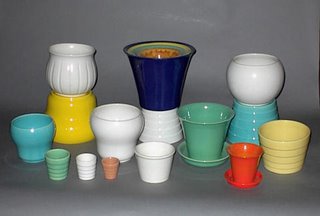 The Tropico Artware line was created the same year that El Patio dinnerware was born, and was designed for both home gardening as well as floral use.
The Tropico Artware line was created the same year that El Patio dinnerware was born, and was designed for both home gardening as well as floral use.Colors included Apple Green , Verde Green, Green, Matt Green, & Gloss Green.
The Flower pot just right of center (with saucer) is Gloss Green.

Montecito duotone in an unusual Satin Green exterior. Original colors included Celadone Green (MP 24), Green (MP62), and the Satin (MP3).

Saguaro Artware came in the Satin Green (MP62) and a Satin Chartreuse (MP45).

Reseda C-464 Tall Footed Green Vase in the Verde Green (MP 68).
Nasco Greens are also unique to the piece.


There are special Greens that will never be duplicated, such as the King Saud dinnerware. Made specifically for the Saudi Royal Family, it included pieces for an entire whole roasted elk to be served at a banquet.

The set was made to "perfection" specifications, with delivered pieces to be *perfect* in every way. This meant that there were many firings and duplicates created when the first pieces came out less than perfect.
 ALL pieces not perfect and ready for delivery were to be destroyed. We have these examples due to the diligence of staff that kept these 2 pieces rather than destroy them. We have spent hours looking at them and never did find what the flaw was on these.
ALL pieces not perfect and ready for delivery were to be destroyed. We have these examples due to the diligence of staff that kept these 2 pieces rather than destroy them. We have spent hours looking at them and never did find what the flaw was on these. The colors are a special green, and Gold- 24 carat gold.
The colors are a special green, and Gold- 24 carat gold. Wednesday, January 17, 2007
 This is "Lilac Rose", an experimental color on the DR pattern that never went into production. There are, to my knowledge, only 5 pieces existing- these 3 (Luncheon, saucer, creamer) and 2 owned by a friend and fellow Collector (creme soup & a second creamer).
This is "Lilac Rose", an experimental color on the DR pattern that never went into production. There are, to my knowledge, only 5 pieces existing- these 3 (Luncheon, saucer, creamer) and 2 owned by a friend and fellow Collector (creme soup & a second creamer).
Tuesday, January 16, 2007
GMcB's designers were sought after throughout the world, and many items that are beloved housewares came from the GMcB corporation with other names attached.
 "During the years that Gladding-McBean / Franciscan created their dinnerware lines, they also contracted with several companies to create promotional items. The most remembered of these is the Toastmaster line, which was created for McGraw Electric Company, but Sunkist, Sperry, Jiffy and others all contracted with Franciscan to produce quality items for their promotions".
"During the years that Gladding-McBean / Franciscan created their dinnerware lines, they also contracted with several companies to create promotional items. The most remembered of these is the Toastmaster line, which was created for McGraw Electric Company, but Sunkist, Sperry, Jiffy and others all contracted with Franciscan to produce quality items for their promotions". More than a dozen items were created for the Toastmaster company to entice home makers to enjoy not just the new electric toast makers, but to display them proudly and plan their entertaining events around them.
More than a dozen items were created for the Toastmaster company to entice home makers to enjoy not just the new electric toast makers, but to display them proudly and plan their entertaining events around them. 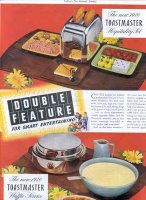
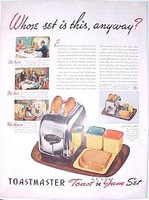 The writers in Toastmasters promotions department created whole scenarios about how Toastmaster was THE most important item in the young brides life, the family's weekend, the busy office worker's morning.
The writers in Toastmasters promotions department created whole scenarios about how Toastmaster was THE most important item in the young brides life, the family's weekend, the busy office worker's morning.The various items came in ONLY the color scheme shown, and were only available in packages with Toastmaster items.
 Toastmaster contracted with several tray manufacturers (and at least one tea caddy maker) to create the trays to display these dining fantiasies.
Toastmaster contracted with several tray manufacturers (and at least one tea caddy maker) to create the trays to display these dining fantiasies. 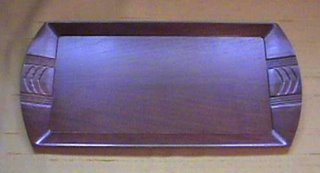 They are all made of wood, some with leather/leatherette inlays. They also contracted with Fostoria, Vicking, and Stangl for items to promote ToastMaster.
They are all made of wood, some with leather/leatherette inlays. They also contracted with Fostoria, Vicking, and Stangl for items to promote ToastMaster. 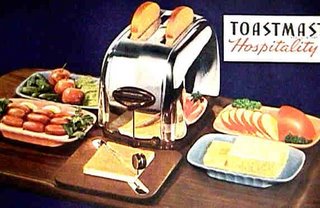
From a friends static web site:
"Toastmaster Promotions
In the late 1930's Gladding McBean (Franciscan) contracted with the McGraw Electric Company (Toastmaster) to produce a number of promotional products as premiums for purchasing Toastmaster Toasters and Waffle Irons. Toastmaster was America's quality manufacturer of kitchen appliances. As a result, a series of jam jars with toast trays, and waffle bowls with syrup pitchers were manufactured.
 There were at least six different jam jar sets and 2 different waffle sets that were produced in large quantities and given away with the purchase of a waffle iron or toaster.
There were at least six different jam jar sets and 2 different waffle sets that were produced in large quantities and given away with the purchase of a waffle iron or toaster. The most elusive pieces out there appear to be the ladles for the waffle sets, and the cutters for the toast.
The most elusive pieces out there appear to be the ladles for the waffle sets, and the cutters for the toast.A typical Toastmaster set would include a wooden hospitality tray along with a Franciscan jam jar set or waffle set. The waffle sets consisted of a batter bowl, a syrup pitcher and a chromium ladle that would measure exactly enough in one scoop to make a waffle.

The jam sets would have one or two jars with lids and a small plate in which toast could be held.
Viking glass and Stangle Potteries also had contracts with Toastmaster in the early years to produce these sets."

Print Advertising for TM was
aimed at the "fun" and special
moments a family could have with their wonderful new Toastmaster serving set.


These small plates have been called everything from "armadillos" to sushi plates, soap dishes, and condiment trays. They were shown as holding appetisers in the original advertising.
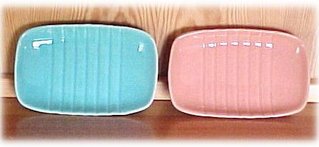
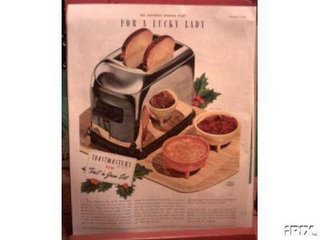
NOTE: The set on the right of the toaster in this as has NOT been identified and to my knowledge no one has displayed these small footed bowls. They might be as elusive as the ladles.
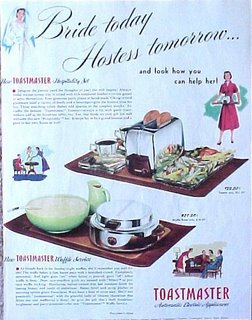
The times were full of stay at home women with clubs, parties, and ladies groups. Toast Master was there.
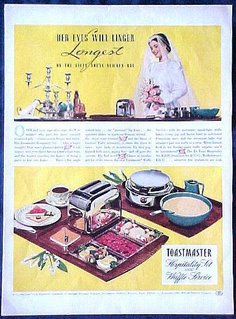
By the end of the war, having Toastmaster kitchen products was considered as important as signing p for fine china, crystal, and flatware due to their specific marketing advertisements.
